THE HANDS BY LORENZO QUINN IN VENICE
You’ll find outside the borders of the Arsenale and the Giardini venues the most interesting things of the Venice Biennale 2017, as I’ve already told you in the post I wrote about my visit at Venice Biennale 2017 to the most important International Art Exhibition. But in that post I suggest that you see Venice and lose yourself in everything the city can offer you.
READ ALSO: Visiting the Venice Biennale: 5 things to know.
Take the first vaporetto sailing down the Grand Canal, and when you are near the Rialto Bridge you’ll see two giant hands supporting the Ca’ Sagredo Hotel.
Those hands are “Support”, an artwork by Lorenzo Quinn.
I asked the artist some questions, so that he could explain me the true meaning of those hands. That’s what he said to me.
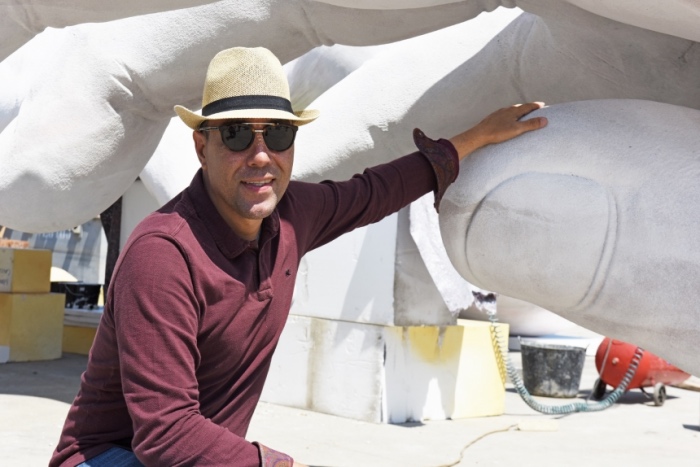
Image source: Creative Boom.com
Caterina Art post Blog: A pair of giant hand emerging from the Grand Canal.
What’s the meaning of this work?
Lorenzo Quinn: I wanted everybody to become aware of the impact of climate changes on fragile places such as the city of Venice: a historic palace which has witnessed the long history of this city, besieged by the flood tide and protected and supported by these two giant hands.
Young hands, of a young boy. The model was my son Anthony who is 11 years old. But these hands are huge and scary, because man is able to save but also to destroy the planet he lives in, and, along with it, even himself and his past.
READ ALSO: Venice Biennale tickets: how to visit it.
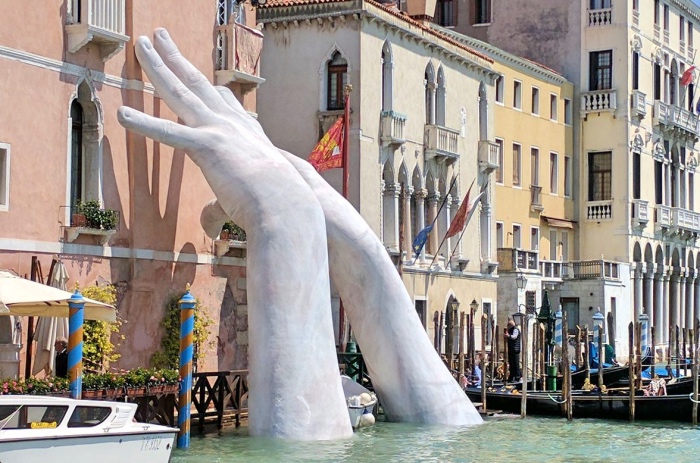
Caterina ApB: Hands is the subject of many of your works.
Why are you so interested in this specific part of the human body?
L. Q.: I’ve always considered hands the most powerful tool human beings can use.
They can create and destroy, radiate either love or hate.
For this reason, I consider them the symbol of the potentiality of the human species, which can save the world but also destroy it and destroy itself together with it. From a technical point of view, I’ve always been fascinated by the challenge of reproducing human hands, because they are the most complex anatomical element to reproduce-therefore, each idea and each new sculpture are new technical goals to reach, as well.
READ ALSO: Things to see in Venice.
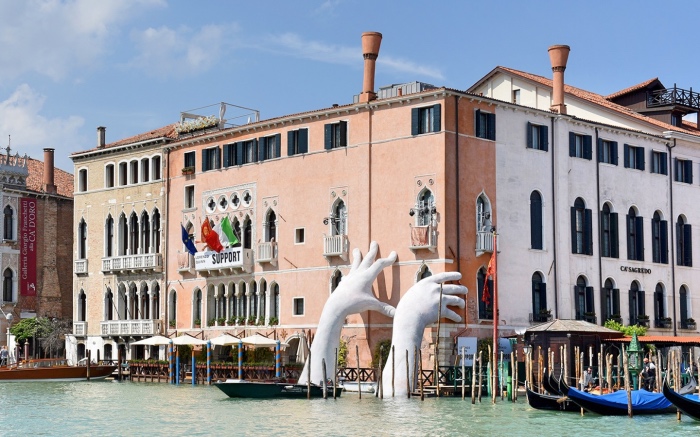
Caterina. ApB: You are son of Anthony Quinn and Jolanda Addolori, Venetian costume designer.
What is your relationship with Venice?
L. Q.: Venice is very special to me. Both my mother and my wife are Venetian.
My religious wedding took place in Venice in 1991, and I celebrated my 50th birthday right here at the Ca’ Sagredo Hotel.
It seems that the most important landmarks in my life have occurred in Venice.
READ ALSO: Venice Biennale tickets: how to visit it.
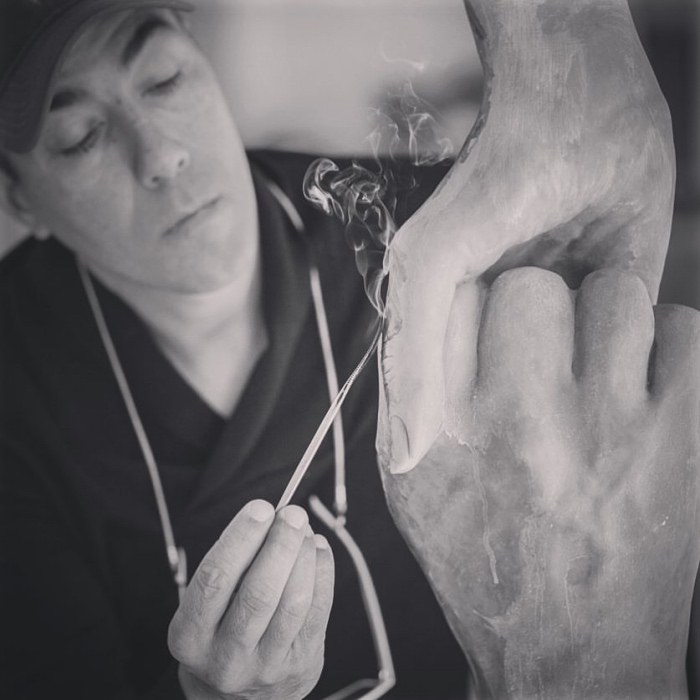
Image source: via Facebook @lorenzoquinnesculturas
LINK
Lorenzo Quinn website – https://www.lorenzoquinn.com


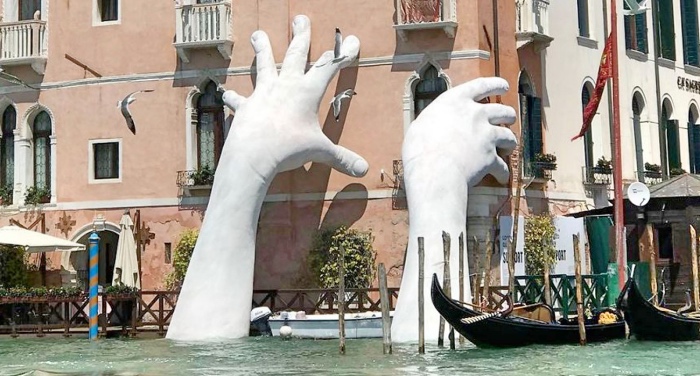
Bellissima !!! Molto interessante !
grazie Louise 🙂
Apprezzo le sculture di Lorenzo Quinn, ma ritengo le “mani” una banale trovata. I significati che si attribuiscono al predetto manufatto lasciano il tempo che trovano. Il destino di tali effimere opere è di finire al più presto nella discarica.
F.to Cesare Cacciavillani Motta
Solo il tempo deciderà se questa opera sia effimera. Se sarà capace di dire qualcosa anche a chi osserverà le immagini di questo evento temporaneo tra 20, 30 40 anni allora è arte vera, se invece verrà dimenticata sarà una delle tante opere.
Per il momento resta una delle opere che incuriosiscono di più i visitatori, molto più di tante altre opere che attualmente sono presenti in Biennale e realizzate dai cosiddetti “artisti di fama”. 😉
E’ evidente che lei difetta di senso critico. Né si accorge che le “Mani” di Lorenzo Quinn altro non sono che una banale opera kitsch uscita dai capannoni dove si approntano i manufatti per il carnevale di Viareggio ! CCM
Il kitsch, inteso come espressione artistica, c’è stato sin dai tempi dell’imperatore romano Caligola.
Comunque, Thorsten Botz-Bornstein, professore di filosofia presso l’università del Bahrain, ha scritto un articolo intitolato ‘How kitsch consumed the world‘, nel quale spiega come il kitsch ‘domina’ il mondo. (l’articola si trova QUI – https://theconversation.com/how-kitsch-consumed-the-world-83823 ).
Secondo l’analisi del professore Botz-Bornstein, questa attrazione per il kitsch ha a che fare la ‘deculturazione’: processo di perdita della propria cultura e dei propri valori da parte di un gruppo sociale.
Se l’arte vera è in grado di interpretare il nostro tempo allora il kitsch e le mani di Quinn sono il perfetto esempio di ciò che siamo.
Tra 300 anni i nostri progenitori osserveranno le mani di Quinn e interpreteranno il nostro pensiero, il nostro stile di vita, la nostra cultura, esattamente quello che noi facciamo davanti ai Fregi del Partenone.
Le “mani” di Quinn altro non sono che una banale opera effimera kitsch ! CCM
Qualcuno sa dove sono adesso le opere “Support” e “Bulding Bridges”? Sono state distrutte?
Non credo siano state distrutte. Erano semplicemente collocate temporaneamente a Venezia e sono tornate all’artista che, ovviamente, può averle vendute a un collezionista. Al momento non vi sono notizie sulla loro attuale collocazione. Io però, se potessi, le comprerei 😀